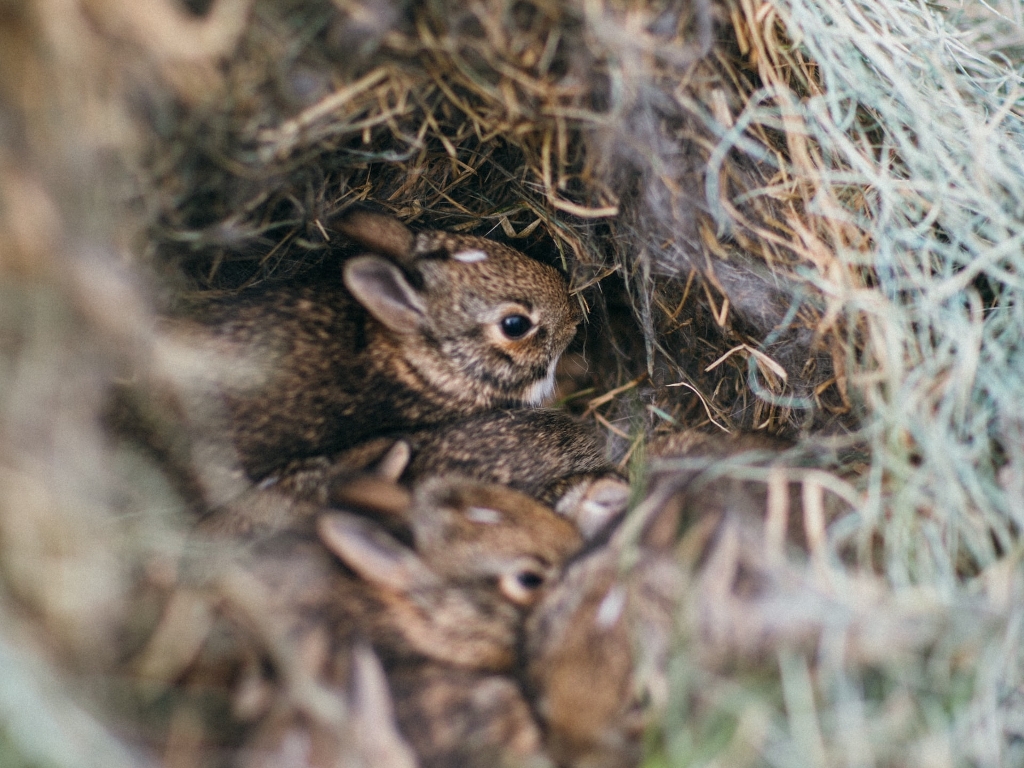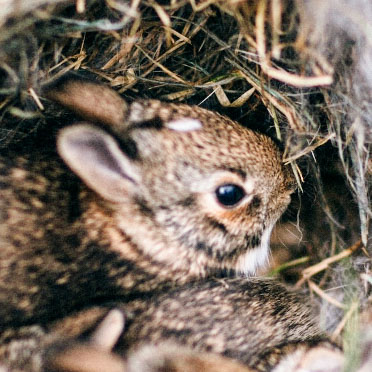Sometimes domestic or wild rabbits are truly orphaned. This document is meant to help in that dire situation.
A few words of caution
Remember that both the domestic pet rabbit and wild bunny moms only feed their young usually once in the middle of the night. Don’t assume the mom is not caring for them if you don’t see her nurse them. Check their tummies to see if they are round and the babies are warm in the morning–this means she is caring for them.
In the rare situation that you have an orphaned domestic bunny, such as when a domestic rabbit mom is sick or refuses to care for her young, you will need to feed the babies. Overfeeding is a leading cause of death in these youngsters, which results in fatal intestinal disease.
How To Feed
Start with a 3 cc/ml syringe or an eyedropper. Feed only with the bunny sitting upright. Point the syringe down towards the bottom or side of the mouth. This way, if too much comes out of the syringe, the baby does not aspirate. At first, they may only take a few drops at one feeding until they are not stressed and used to this.
The Bunny is Domestic (not wild) and Really Orphaned – How do I care for it?
In the rare situation that you have an orphaned bunny, such as when a domestic rabbit refuses to care for her young, you will need to feed the babies. Overfeeding is a leading cause of death in these youngsters which results in fatal intestinal disease.
Use KMR kitten or regular goat’s milk. An eye dropper or 3 cc syringe can be used to feed. Feed only upright, and point the syringe down towards the bottom or side of the mouth so that if too much comes out, the baby does not aspirate.
Domestic buns with closed eyes should be fed 2-3x/day (but only 2x/day for wild bunnies), and the number of feedings gradually decreased until they are weaned. If their eyes are still closed, you need to stimulate their bottoms with a warm moist towel after feedings to help them to pee. (Domestics are weaned about 6 weeks; wild bunnies are weaned about 3-4 weeks for cottontails and 7-9 weeks for jacks). Bloat is commonly associated with too frequent feedings. If you have questions, their phone is 800/323-0877. For WILD rabbits, use KMR KITTEN formula– never puppy formula or Esbilac. If you can’t find it, use Regular Goats Milk (found in the carton at your grocery) or KMR, NOT Esbilac. But again, this is only until you get them to a rehabber so they can be cared for properly and with others to bond with before release. Home raising of wild bunnies results in more babies dying.
Preparing a Nest – Domestic Babies
Provide a soft nest area in a box with clean towels, and cover the babies so it is dark. Do not provide extra heat if the room temperature is at least 65 to 70o F because excessive heat can be fatal. If this is a wild rabbit, handle it ONLY when during feedings as excessive handling can be extremely stressful and potentially fatal.
You can use KMR (Kitten Milk Replacer) available at most pet stores for the handfeeding formula. You can also use Regular Goats Milk found in the carton at your local grocery store.
How much formula should I feed?
The following is a guideline for the daily amount to feed a wild bunny or a domestic bunny. Take the DAILY amount listed and divide it into the proper number of feedings.
Domestic buns with closed eyes should be fed 2-3x/day, (2x/day for wild bunnies), and the number of feedings gradually decreased until they are weaned. (Domestics are weaned about 6 weeks; wild bunnies are weaned about 3-4 weeks for cottontails, and 7-9 weeks for jack rabbits). Bloat is commonly associated with too frequent feedings.
Wild bunnies should be fed kitten KMR or KMR and regular Goats Milk. Do not use Esbilac for wild rabbits. It is okay for domestics.
| Rabbit Wt (gm) | Av. Feedings/Day | Av. Formula Intake (cc) |
| 35-50gm | 3-5 | 8-11cc |
| 50-65gm | 1.5-3 | 10-13cc |
| 65-80gm | 1.5-3 | 13-18cc |
| 80-95gm | 1.5 | 15-20cc |
| 95gm> | max 2 | max 20cc |
The following is a guideline for the daily amount to feed an orphan that will be approximately 5 lbs as an adult…you can increase the amounts as needed for larger breeds: Take the DAILY amount listed and DIVIDE into TWO feedings.
| Age | Average Formula Intake |
| Newborn | up to 5cc KMR or goats milk (½ of this each feeding) |
| 1-2 weeks | to 10-15cc KMR or goats milk (½ of this each feeding) (depending on bunny..may be much less if smaller rabbit) |
| 2-3 weeks | to 26-30cc KMR or goats milk (½ of this each feeding) (Eyes open at about 10 days of age. Start introducing them to hay, pellets and water (add greens for wild ones). |
| 3-6 weeks | to 26-30cc KMR or goats milk (½ of this each feeding) (again, may be less depending on size of rabbit…) |
cecotropes
If you have a healthy adult rabbit at home and you can collect cecotropes (the soft green droppings that the rabbit usually eats) then these can be mixed with the KMR to give the baby bunny normal bacteria for its intestinal tract. Only one cecotrope per day for 4-5 days is needed. This is particularly important for rabbits under one week of age. Also good is to sprinkle acidophilus powder from human capsules in the milk a little each time for healthy flora.
Stimulation for Urination & Defecation
After each feeding, for the first 10 days of life or until their eyes are open, it is important to gently make the bunny defecate and or urinate to keep the intestinal and urinary system running smoothly. Use a cotton ball moistened with warm water after eating, and gently stroke the anal area until the bunny starts producing stool and urine and keep stroking until the bunny stops. You are reproducing the behavior of the mother rabbit who would lick her young to stimulate them to go to the bathroom and to keep the nest clean.
This stimulation is required for all domestic rabbits and wild cottontail or brush rabbit babies. Jackrabbits do not need this intervention, they eliminate on their own.
Domestic Orphans: Adding Solids & Weaning
As soon as their eyes are open, you may introduce the bunnies to plain alfalfa pellets, alfalfa hay, oat hay, and timothy hay. Fresh greens should be avoided.
Domestics are weaned at about 6 weeks.
Wild Orphans: Solids, Weaning & Release
As soon as the wild bunnies’ eyes are open, you may introduce them to plain alfalfa pellets, hay, such as oat hay, timothy, alfalfa and veggies such as carrot tops, Italian parsley, dandelion greens. Dandelion greens and hay (timothy and oat hay) are extremely important for wild rabbits. You can add whole oats from a feed store, and some grated carrots. The greens must be fresh, rinsed, and replaced if not eaten in a few hours.
Wild rabbits should be released as soon as they are eating hay and greens and are approximately 5 inches in body length (cottontails). They will be small, but the longer you keep them, the more agitated and difficult to handle they will become and the less likely their chances for survival in the wild. Release ONLY at dusk or dawn. Jack rabbits will be much larger and are released after 9 weeks when ready. Make sure they get exercise daily.
Further Reading
- Wild Babies: Are The Really Orphaned?
- Baby Eastern Cottontail Rabbit Reuniting Guide (Dane County Humane Society)
- How to Find a Rabbit-Savvy Veterinarian
©Copyright Margie Wilson. All Rights Reserved. Republished with the permission of the author.

